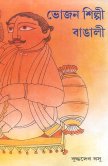bhojanshilpI bAMAlI
buddhadeb basu
basu, buddhadeb [Buddhadeva Bose]; damayantI basu singh (intro);
bhojanshilpI bAMAlI [Bhojon Shilpi Bangali]
bikalpa kolkata 2004
ISBN 8188098183
topics: | food | bengal | india | history
As damayantI basu writes in the introduction, Buddhadev Bose never went into a kitchen. Yet his discussions on food remain fascinating.
The book is based on a series of four articles, first titled "Bhojan-Bilasi Bangali" but later changed to "Bhojon-shilpi Bangali" which appeared in 4 daily installments in the Ananda Bazar Patrika of Calcutta, January 1-4, 1971. (from parabaassee below). Illustrations by well-known contemporary artist Ramananda Bandyopadhyay.
Excerpts
There is nothing called "Indian literature," - as I have been saying in so many forums - similarly, there is nothing called "Indian food". It would be hard to design a meal that would be equally enjoyable for a Sikh, a Tamil and a Bengali.
[On a trip abroad, his host arranges an Indian dinner, with an Indian
family.]
"What state are they from?" I asked cautiously. He doesn't know. It
turns out they are Tamil. I can manage only a bit of plain rice with
coffee. But I find no need to apologize for my parochialness - the fish
aroma emanating from a Bengali kitchen would cause a Tamil brahmin to
swoon.
Sharing Indian food is the unending story of the crane and the fox
inviting each other. 1
[AM: Food habits are a product of our childhoods. One rarely meets Bengalis
nowadays who are so insular in their food habits as to be unable to taste
food at a Tamil table. At the same time, the food served in Tamil
restaurants in Kolkata is a bleached version of what is eaten in the Madurai
home.
As the world expands, one is exposed to more varied experiences. The bengali
housewife learns to appreciate masala dosa or thai green curry or spaghetti,
perhaps even introducing some of these into her repertoire. After all, it is
instructive to realize that some ten generations back, we did not have
potatoes, tomatoes, green chilly, onion, etc in Bengali cooking, and we
learned about tea drinking only three generations back, and even sugar was a
rarity in most of Bengal fifty years back. ]
The mahabhArat contains no reference to the items of food, though there are
instances of feasts, there is no mention of the items served.
While bengali lacks many words like the word for pANi (arm) or piMgala
(copper-yellow), it does very well in terms of food terms. What is the
difference between a chacchari and a ghanTa, and how do these differ from the
lAbrA.
[note strange spelling with tAlabya sha - khAshA + others]
Links:
After I transcribed the above, I found a complete English translation, by BB
himself, which had appeared in Hindusthan Standard, Calcutta, and is
now online at parabaas
amitabha mukerjee (mukerjee [at-symbol] gmail.com) 2010 Feb 02
